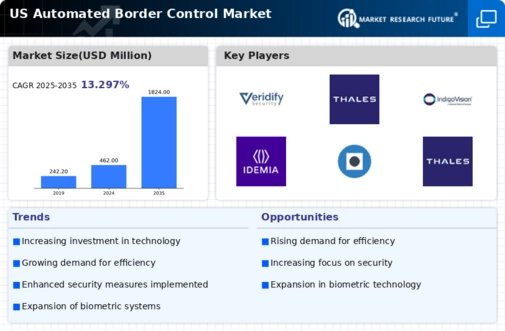The US Automated Border Control Market is experiencing notable trends driven by advancements in technology and a growing focus on enhancing border security. Increased demand for efficient and streamlined border security solutions is evident as the US government aims to improve the traveler experience while maintaining effective immigration control. The implementation of biometric technologies, such as facial recognition and fingerprint scanning, has become more prevalent, facilitating faster and more accurate identification of travelers at borders and airports.
This shift not only enhances security measures but also accelerates the processing time for travelers, which is particularly crucial during peak travel seasons.There are considerable opportunities emerging within this market as various stakeholders look to invest in innovative automated border control systems. The growing emphasis on public safety and national security postures has created a need for comprehensive solutions that can mitigate risks while enhancing operational efficiency. Additionally, an increase in international travel and tourism is prompting the need for upgrades and expansions of existing border control infrastructure, creating a favorable environment for new technologies and partnerships.
Recent times have seen a surge in government initiatives aimed at modernization, with agencies like the Department of Homeland Security championing proposals for deploying smart technologies at border crossing points.These initiatives highlight the trend toward integrating automation into border control processes across the US. Furthermore, the collaboration between technology providers and government agencies is fostering the development of tailored solutions that meet the specific needs of the US market, ensuring both compliance with regulations and improved user experience.
This landscape underscores a dynamic evolution in how border management is approached, indicating a future that leans heavily on digitization and automation for enhanced security and efficiency.
Increasing Focus on Border Security
The US Automated Border Control Market Industry is driven primarily by the increasing focus on border security and immigration control. The US Department of Homeland Security has reported a significant rise in border security incidents, projecting an increase of 20% in border enforcement actions over the past two years.
This escalation necessitates the implementation of advanced Automated Border Control solutions, which facilitate quicker and more efficient processing of travelers while maintaining high security standards.As a result, several established organizations like the Transportation Security Administration (TSA) and Customs and Border Protection (CBP) are investing heavily in Enhanced Automated Border Control technology, which has led to a greater urgency in their deployment across various entry points into the United States. The ongoing threat of border-related security incidents enhances the necessity for such technologies, ultimately driving growth in the US Automated Border Control Market.
Technological Advancements
Technological innovation plays a crucial role in the expansion of the US Automated Border Control Market Industry. The adoption of cutting-edge technologies such as biometric identification systems has risen dramatically, with the US government noting a deployment of over 30 million biometric scans performed at entry points in the last year alone. Organizations such as the Federal Bureau of Investigation (FBI) and other federal entities are continuously enhancing their biometric identification capabilities.These advancements not only streamline the border crossing process but also significantly reduce processing time, contributing to higher efficiency and satisfaction among travelers.
The booming growth of technology startups in the US focused on automation and biometric verification is also increasing competitiveness in the industry, further propelling market prospects.
Rising International Travel
One of the main drivers of the US Automated Border Control Market Industry is the resurgence in international travel. Following the Covid-19 pandemic, the US saw an increase in traveler volume, with the International Air Transport Association reporting a 70% increase in international flights and arrivals during the current fiscal year compared to the previous year.
As a result, US border control agencies require more sophisticated Automated Border Control systems to ensure a seamless flow of passengers while enhancing security measures.Established organizations like Airlines for America and the International Air Transport Association have emphasized the need for modernization in federal and airport services to handle increased passenger volume effectively. This pressing demand contributes to the overall growth of the Automated Border Control market, aligning with the uptick in global travel.






















Leave a Comment